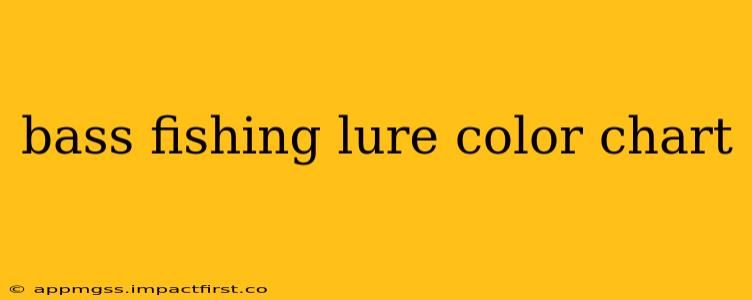Choosing the right lure color can significantly impact your bass fishing success. Water clarity, time of day, and even the type of cover all play a role in determining which colors bass will find most appealing. This comprehensive guide will delve into the effectiveness of various lure colors under different conditions, helping you select the optimal shade for a successful fishing trip.
What Factors Influence Bass Lure Color Choice?
Before we dive into a specific color chart, it's crucial to understand the factors influencing a bass's preference for a particular color.
-
Water Clarity: In clear water, natural colors like shad patterns, greens, and browns often work best. Bass can easily see your lure, so mimicking the natural prey is key. Conversely, in murky or stained water, brighter, more contrasting colors like chartreuse, orange, or white become more effective. These colors help the bass detect the lure from a distance.
-
Time of Day: Low-light conditions (dawn and dusk) often favor darker colors or lures with subtle flash or glitter. These colors help the lure stand out against the subdued background. During bright daylight hours, more natural or subdued colors may be more effective, especially in clear water.
-
Water Temperature: Water temperature affects a bass's metabolism and feeding behavior. Cooler water often leads to a preference for darker, more subdued colors, while warmer water can see a shift toward brighter colors.
-
Type of Cover: The type of cover also plays a role. Around heavy vegetation, darker colors might be more effective as they blend in better. In open water, brighter colors may attract more attention.
-
Season: Bass feeding patterns change throughout the year. This often correlates to a change in their color preference. Experimenting with different colors throughout the seasons is essential.
Bass Fishing Lure Color Chart: A Breakdown by Color
While there's no universally perfect chart, here's a breakdown of common lure colors and their effectiveness in various conditions:
Natural Colors:
- Brown/Green: These colors are excellent imitations of natural prey like crawfish and shad, working well in clear water and during the day.
- Olive Green: Another great natural color that closely resembles aquatic insects and vegetation.
- Clear/Natural Shad: Highly effective when you want a subtle presentation, mimicking baitfish in clear water.
Bright Colors:
- Chartreuse: A highly visible color that's excellent in stained or murky water. Chartreuse lures are often great at attracting aggressive strikes.
- Orange: Similar to chartreuse, orange is a highly visible color that works well in low-light conditions or stained water.
- White: A classic choice that is highly visible and effective in various conditions, particularly in cloudy water or at night.
- Yellow: A bright, highly visible color that can be particularly effective during overcast days or in deeper water.
Dark Colors:
- Black: Works well in dark, muddy water or during low-light conditions.
- Purple: Can be effective in both clear and stained water, often performing well at dawn and dusk.
Frequently Asked Questions (FAQs)
What is the best bass lure color for stained water?
Brighter colors like chartreuse, orange, and white are highly visible in stained water, increasing the chances of a bass spotting your lure.
What lure colors work best at night?
Darker colors or lures with added flash or glitter are generally better at night, as they stand out against the dark background. White can also be surprisingly effective.
Do bass prefer certain colors during the different seasons?
While there's no definitive answer, bass tend to favor more natural colors in clear water during the spring and summer when baitfish are more abundant. As the water cools, darker colors can become more effective. Experimentation is key!
Does the type of lure affect color choice?
Yes, the type of lure affects color choice. For example, a topwater lure might benefit from a brighter color for better visibility, whereas a jig might be more effective in a natural color to blend in with the bottom structure.
How can I determine the best color for a specific location?
The best approach is to experiment. Start with a few staple colors (e.g., chartreuse, brown, white) and observe which colors trigger the most strikes. Local fishing reports and conversations with other anglers in the area can also provide valuable insight.
By understanding these factors and using this guide as a starting point, you'll be well-equipped to choose the right lure color for your next bass fishing adventure. Remember, consistent experimentation and observation are crucial to mastering the art of bass fishing.
